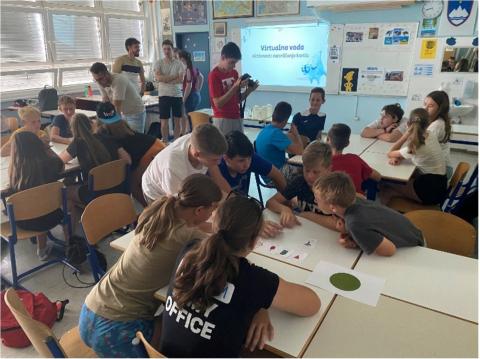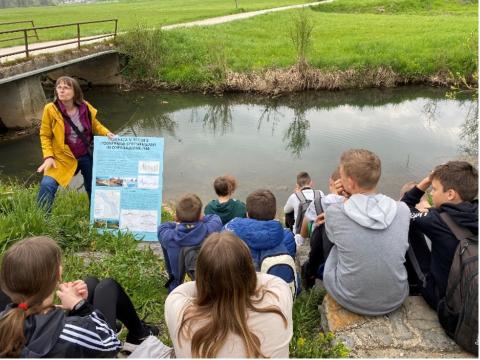Empowering local communities for their river resources
Along the floodplain of the river Temenica, in Southeastern Slovenia, lies the town of Trebnje, a small settlement of 15,000 inhabitants. In this rural area, the river plays a major role in the economic, environmental, and social development policies of the local municipality. In 2022, the municipal council agreed to invest in an important river revitalisation project, to enhance and improve the management of the water resource.
This project is called Rusalka, it is a Community-Led Local Development (CLLD) initiative, aiming at educating young people about responsible water resource management while raising public awareness of the natural and cultural heritage of the Temenica river region. The project aims to cultivate a sense of ownership and environmental responsibility within the community by actively involving hard-to-reach groups in addressing specific local societal challenges.
Sara Mikolič, University of Ljubljana, who supported the Rusalka project believes that:
"To foster a sustainable future, it is imperative that we pay special attention to children and young individuals who will assume the roles of change agents and innovators in water management."

Leveraging CLLD through the Rusalka project, the Municipality of Trebnje secured co-financing from the European Regional Development Fund and Slovenia’s LEADER/CLLD programme. The project is steered by the Local Action Group, STIK, comprising:
- Municipality of Trebnje
- Local elementary school
- Local company, Gorec, with expertise in small wastewater treatment plants
- Local not-for-profit associations
Moreover, this civic engagement of the University of Ljubljana was important to bring additional support and capacities to the Municipality and the Local Action Group to design and implement Rusalka.
The involvement of all local players is a key success factor for the project. Sara Mikolič states that:
"in contrast to the limitations of top-down river basin management plans, smaller watersheds are now witnessing a surge in grassroots initiatives aimed at more effective water management. Empowering stakeholders and the local population living alongside water bodies plays a vital role in this new bottom-up approach.
One critical factor influencing the acceptance and success of water management efforts is the integration of water-related education at all levels of learning, coupled with its practical application within local communities."
The methodology adopted in Rusalka was influenced by a number of practices that the Municipality of Trebnje witnessed by participating in the Interreg Europe project AQUARES such as:
- The educational programmes on water reuse for children in Murcia, Spain.
- The environmental awareness raising initiatives like RHYME, z. s., H2Ospodař, in the Czech Republic.
Trebnje incorporated similar educational workshops into the Rusalka project. These workshops covered topics such as water resource conservation, quality, and responsible use. Additionally, the project involved the revitalisation of a degraded area along the Temenica river, the creation of an e-educational water path, workshops on wastewater treatment, and various awareness-raising activities.
In addition to the transfer of these good practices, and as a result of the participation of Trebnje in AQUARES, the project Rusalka was integrated into the new Local Development Strategy. This outcome highlights a long-lasting influence to promote water management for the region’s future development.
Rusalka serves as a demonstration of how CLLD can effectively drive incremental transformative changes to address specific, place-based societal challenges, including water resource management and environmental awareness.
Community-Led Local Development is a European method to support public authorities in pursuing integrated territorial development (Common Provisions Regulation).
This approach seeks to actively involve local communities and stakeholders in the creation and execution of strategies and projects designed to tackle local development challenges while making collective decisions on the allocation of EU funds. CLLD primarily supports local development initiatives in rural or urban areas with populations ranging from 10,000 to 150,000 residents.

CLLD places local communities and stakeholders at the centre of decision-making processes. It encourages active participation and engagement at the local level, allowing communities to identify their specific needs and priorities. Compared to other integrated approaches such as Integrated Territorial Investments, CLLD is a strictly bottom-up approach.
Local Action Groups (LAGs) are typically responsible for implementing CLLD strategies. These groups consist of representatives from local communities, public authorities, civil society organisations, and other relevant stakeholders. They collaborate to identify priorities, develop strategies, and select projects for funding.
Supportive capacity-building tools are necessary to promote effective governance within LAGs and to address challenges associated with pursuing CLLD. These challenges may include a lack of awareness, bureaucratic burdens, and limited local administrative capacities (European Commission).
CLLD builds local community capacity and ownership particularly among hard-to-reach groups, allowing local communities to shape EU objectives across all priorities.
CLLD is often used to address place-based challenges in specific subregional areas. It takes into account the unique characteristics, strengths, and weaknesses of each area, allowing for tailored development solutions.
CLLD promotes an integrated approach to territorial development, where integration implies multi-funds, multi-sectoral policy, multi-level and multi-stakeholder governance, multi-territorial and community-led strategy.
CLLD can address a wide range of objectives, including rural development, urban regeneration, employment, social inclusion, and sustainable environmental practices.
CLLD can be applied under various EU funds, including the:
- European Regional Development Fund
- European Social Fund
- European Agricultural Fund for Rural Development
- European Maritime and Fisheries Fund
This flexibility enables a wide range of projects and initiatives to be supported.
CLLD is a dynamic approach that champions incremental small wins, involving small-scale, bottom-up initiatives guided by a shared agenda to address place-based societal challenges (Bours et al.). Instead of pursuing bold and radical changes, CLLD highlights the power of small, consecutive actions that accumulate and ultimately lead to transformative changes.

